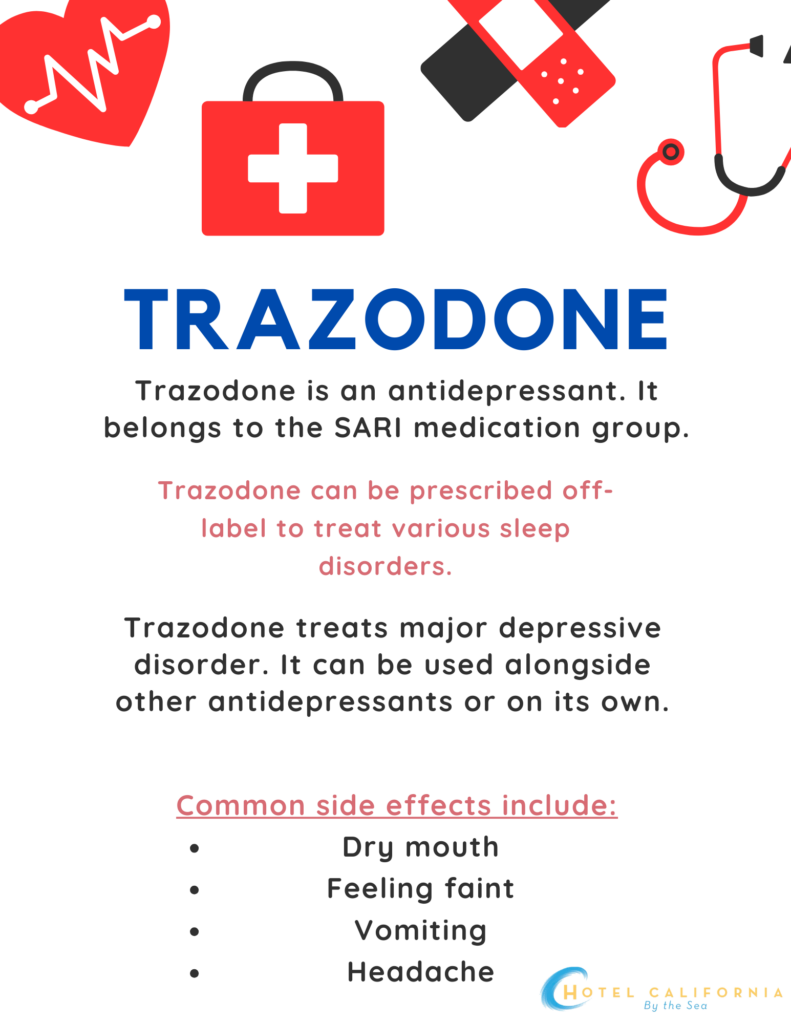Is Trazodone a Controlled Substance?
Trazodone is a medication most often prescribed under the brand name Oleptro to treat sleep disorders, anxiety disorder and unipolar depression disorder. Trazodone increases natural neurotransmitters in the central nervous system that help to restore the imbalance of chemicals in the brain. It is not a commonly abused substance. However, there is potential for the drug to be abused and cause an addiction when being used other than per the recommendation of licensed clinicians.

The cause of depression is still not fully understood, but many believe it involves an imbalance of neurotransmitters such as serotonin and dopamine in the brain. The most commonly prescribed treatments for depression are reuptake inhibitors which work to keep the level of neurotransmitters high. This can help regulate mood, making users feel more relaxed and calm. Trazodone is a medication commonly prescribed to treat symptoms of depression to improve mood, reduce anxiety and promote better sleeping habits. There are also many types of other antidepressant medications that work to inhibit the reuptake of certain neurotransmitter chemicals in the brain.
Antidepressant medications usually fall under three different categories. Selective serotonin reuptake inhibitors (SSRIs) are medications such as Prozac, Zoloft and Lexapro. Serotonin and norepinephrine reuptake inhibitors (SNRIs) are medications such as Cymbalta and Effexor. And a norepinephrine and dopamine reuptake inhibitor (NDRI) is a medication such as Wellbutrin. Trazodone doesn’t fall under either of these categories. It is what is known as an atypical antidepressant. It is a serotonin antagonist and reuptake inhibitor (SARI) and works by increasing serotonin production and preventing serotonin from being reabsorbed by the brain and body.
What is Trazodone? Is Trazodone a Controlled Substance?
Trazodone is not a controlled substance. It is an inexpensive prescription generic drug that is covered by most insurance policies. Because it is not a controlled drug, physicians aren’t limited to how much can be prescribed. It can produce the onset of sedative effects within about 30 minutes. In some cases, the drug can take up to two weeks to produce significant results in helping to treat symptoms of anxiety and depression.
Trazodone is a unique antidepressant. Not only does it help to increase the production of serotonin, but it also works to block its reuptake by the body allowing for more of the “feel good” chemical to be available. This promotes feelings of calm, relaxation and positivity. It manages the overall serotonin activity in the brain.

Side effects of Trazodone misuse include:
- Drowsiness
- Dizziness
- Headache
- Fatigue and sedation
- Blurred vision
- Disorientation
- Vertigo
- Shaking
- Anxiety
- Muscle ache
- Low blood pressure
- Increased risk of suicidal thoughts
- Acting on dangerous impulses
- Insomnia
- Weight gain and loss
- Serotonin syndrome
Serotonin is a chemical regulated by trazodone. Serotonin is a chemical that helps to regulate the internal clock for resting, being awake, mood, appetite, digestion and memory functions. Serotonin syndrome occurs when high levels of serotonin accumulate in the body. Too much serotonin can cause tremors, muscle aches, anxiety, confusion, delirium, hallucinations and seizures.
What are Controlled Substances?
Controlled substances are drugs the federal government has deemed to have the potential to be abused and can lead to dependence or addiction. President Richard Nixon signed the Controlled Substances Act into law in 1970. It establishes a federal policy to regulate the manufacturing, distribution, importing/exporting and use of specific regulated substances. It was created as a way to regulate the potential of a substance for abuse versus medical validity.
The power to label and dictate which substances are considered under the policy falls within the jurisdiction of the FDA and DEA. These federal agencies collect all relevant data, and request scientific and medical evaluations along with recommendations when considering placement of a drug into a controlled substance category known as schedules. The process to remove, add or change the schedule of a controlled substance can be proposed by the DEA, Department of Health and Human Services or a petition from the interested party.
Most prescription medications for infections or chronic conditions are not considered controlled substances. These medications include blood pressure and cholesterol medication, diabetes medications, asthma inhalers and antibiotics. However, pain management medications such as opioids are considered controlled substances.
Check Your Insurance Coverage for FREE
Find out if your insurance covers addiction treatment in minutes. We accept most insurance!
Classifications for Controlled Substances
Controlled substances have the potential to cause physical and mental dependence and have restrictions on how they can be distributed and refilled. Oftentimes the abuse rate of a drug can be a determining factor in the scheduling of the drug and whether or not there is a potential for medical use.
The DEA classifies controlled substances into five different categories. The category in which a drug falls determines its legal status and the extent of regulations and restrictions that surround the drug. Schedule I drugs have a much greater potential for addiction compared to a Schedule III drug.
- Schedule I Controlled Substances. These substances are drugs with no medical use and a very high potential for abuse. These types of drugs are not even available with a prescription. Drugs that fall into this category include heroin, LSD, ecstasy and marijuana.
- Schedule II Controlled Substances. These substances are medically approved, yet still have the potential for addiction and dependence. These drugs are highly regulated and can only be obtained through a prescription from a licensed clinician. Prescription refills are not allowed with Schedule II substances. Patients must obtain a new prescription every time. In some states, prescriptions for Schedule II drugs require a handwritten letter signed by the physician. Drugs that fall into the category include methamphetamine, oxycodone, fentanyl and Adderall.
- Schedule III Controlled Substances. These substances are usually prescription drugs with a moderate potential for abuse. Patients can receive a refill for up to five times within the span of 6 months. Drugs that fall into this category include Tylenol with codeine, anabolic steroids and ketamine.
- Schedule IV Controlled Substance. These substances are prescription drugs with a very low potential for abuse. Drugs that fall into this category include Xanax, Valium and Ambien.
- Schedule V Controlled Substance. These substances can be prescription medications or over-the-counter drugs with minimal amounts of addictive substances added. Drugs that fall into this category include cough syrup or suppressants with codeine and anti-diarrheal medications.
Reach out to Hotel California by the Sea
We specialize in treating addiction and other co-occurring disorders, such as PTSD. Our Admissions specialists are available to walk you through the best options for treating your addiction.
Are you looking for treatment for Substance Use Disorder?
Trazodone, although not a controlled substance, can have the potential for misuse. Abuse of the drug typically happens when a person takes more of the drug than prescribed or is taking it in combination with other drugs. It is most commonly used to treat symptoms of depression and can cause feelings of sedation and intense relaxation. This helps with fighting off depression and insomnia because it inhibits the reuptake of serotonin as well as increases serotonin production to compensate for the chemical imbalance. Despite its popularity, there are still very limited studies on the short and long-term effects of the drug. Hotel California by the Sea offers substance use disorder treatment for those who may be abusing prescription medication such as trazodone.
We provide all levels of care including detox, inpatient residential, partial hospitalization program and intensive outpatient program. We also utilize evidence-based therapies including CBT, DBT and group therapy. The combination of medications, and individual and group therapies can help clients overcome their addiction and co-occurring mental health conditions. Hotel California by the Sea is dedicated to supporting our clients in every step of their recovery journey.
References:
https://www.hazeldenbettyford.org/articles/trazodone
https://www.addictionresource.net/controlled-substances/trazodone
https://www.rehabcenter.net/trazodone/controlled-substance
https://recovered.org/antidepressants/trazodone/is-trazodone-a-controlled-substance
https://www.dea.gov/drug-information/drug-scheduling
https://www.goodrx.com/drugs/medication-basics/what-are-controlled-substances
